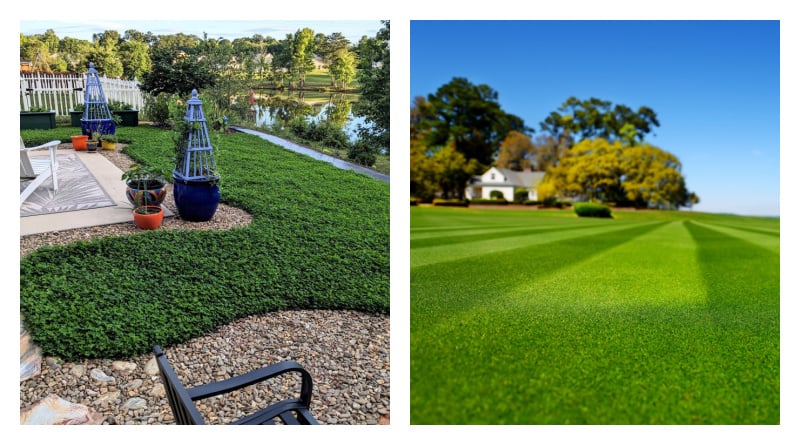Grass Seed vs. Miniclover: Which Lawn Option Is Right for You?
If you are planning a new landscape, grass seed and Miniclover® are two standout choices to consider when it comes to establishing a vibrant, healthy lawn or yard area. For those interested in a classic lawn with a traditional appearance, turfgrass seed may be the best choice. Or, try Miniclover seeds if you are looking for a unique, low-maintenance lawn alternative. Outsidepride offers both options as well as many other high-quality seeds and online resources to help homeowners plan and grow healthy and lush outdoor spaces.
Benefits of Grass Seed
One of the many benefits of using grass seed for your lawn is the fact there are a wide variety of seed types for different climates and uses. Whether you live in hot, cold, dry or wet conditions or anything in between, there is a grass seed variety that will suit your needs. There are also many grass seeds to fit different lifestyles, such as grass seeds that can tolerate high-foot traffic or types that are meant for areas with lower foot traffic.
Classic green lawns grown from seeds, whether they are fescue, bluegrass, Bermuda or another type of grass seed, offer the classic curb appeal many homeowners love.
Seeding a Lawn with Grass Seed
The timing for seeding a new lawn is different for cool season grasses than it is for warm season grasses. For cool season grasses, the soil temperature needs to be at least 55 degrees Fahrenheit; though, the soil temperature must be at least 65 degrees Fahrenheit for warm season grasses. Depending on the grass species, 6 to 12 weeks of good growing weather is needed to get the best establishment of the turf. This timing makes mid-spring or early-fall plantings ideal for cool season grasses, and spring plantings preferable for warm season grasses.
Before seeding your new lawn, it is important to know which type of grass seed is best suited for your region.
- Cool Season Grasses: This type of grass grows best during the cooler months of spring and fall when temperatures are mild and is particularly well-suited for regions that experience cooler temperatures. Cool season grass seeds usually grow rapidly in cooler seasons, offering a vibrant lawn appearance. Poa Supina Shade Grass Blend w/ OptiGrowth from Outsidepride is an excellent choice for dense shade in cool season areas. OptiGrowth is a seed-coated enhancement that improves seed uniformity, ease of spreading and soil contact during overseeding. Its moisture-retaining Aquatek absorbent boosts germination, while a blend of essential nutrients promotes healthy growth.
- Warm Season Grasses: Warm-season grasses flourish in warmer climates where temperatures are consistently higher. These grasses typically thrive during the summer months and can go dormant in cooler temperatures, making them a great option for regions that experience hot summers. Try Outside pride’s Buffalo Grass – Supreme for a lush, drought-tolerant turf that thrives in diverse conditions and requires minimal care.
Water the newly seeded lawn gently with an oscillating type of sprinkler. It is crucial to keep the seeds moist until the grass begins to grow, so several waterings a day may be required. Once the seeds start growing, decrease the watering frequency and increase the watering duration to ensure a deep-rooted, vigorous lawn.
Each watering should moisten the soil to a minimum depth of 6 inches. This is the grass’ active root zone. The length of time and amount of water it will take to moisten the root zone depend on soil type and the irrigation system.
Implementing proper lawn care techniques in the early stages of growth will set your lawn up for long-term success. Fertilization is one of these best practices. Fertilizing your lawn provides it with the nutrients needed for developing roots and will boost the vitality and resilience of your lawn.
While every region and lawn is different, planning and using well-chosen grass seeds is essential for success.
Benefits of Miniclover Lawns
Miniclover is a self-fertilizing, drought-tolerant and sustainable lawn alternative—what’s not to love? It also is a low-maintenance option, requiring far less mowing than a traditional grass lawn.
After just a few mowings, it can be trained to maintain a height of just 3 inches, eliminating the need for regular mowing. Its “non-traditional” aesthetic brings a unique, textured look to your landscape.
Outsidepride Perennial White Miniclover or microclover is ideal for dry conditions, enriching the soil health of a lawn space. These ground covers minimize watering and fertilizing needs, making them more cost-effective than other types of clovers. Adding even a very small amount of Miniclover to an existing area will improve the color, increase drought tolerance and crowd out unwanted plants.
Seeding a Lawn with Miniclover
Miniclover seeds should be planted in late-winter, early-spring or late-summer in the southern United States and early-spring or late-summer in the northern United States.
Miniclover adapts well to a variety of soil and climate conditions. It tolerates partial shade, drought and wet conditions, but it should not be planted in areas prone to flooding or standing water. Like grass seeds, Miniclover seeds need to be consistently moist until they are established.
If you are seeking an easy-to-establish, low-maintenance lawn alternative, Miniclover can be used to complement an existing lawn or serve as a complete groundcover solution. Miniclover is loved for its low-maintenance qualities, such as its infrequent and easy care needs.
If a Miniclover lawn is never mowed, it will get approximately 6 inches tall, possibly higher, depending on its growing conditions. Once it is mowed, it will only grow slightly past the height it was mowed. Because of this, a Miniclover lawn can typically be trained to remain at a height of 3 inches, making the maintenance and upkeep of the growth very minimal.
There is more than one way to grow a lush and healthy yard. Whether you are drawn to the timeless appeal of a traditional grass lawn or intrigued by the low-maintenance qualities and unique appearance of Miniclover, Outsidepride offers dependable seed options to suit your needs.
To learn more about Outsidepride’s grass, Miniclover and other seed choices as well as helpful planting resources, visit www.outsidepride.com and follow Outsidepride on social media.





As someone considering a lawn, I find this post super helpful and timely. I had no idea that there was such a grass seed variety. Being a newbie, I think Miniclover will be it. The low maintenance and minimal mowing sounds about right. And we can save on fertilizers and sprinklers when rain is scarce? Sold!
Honestly, my neighbour’s the one who mows our lawn, and I’ve been feeling a little guilty about how uneven and sad our grass looks in spots. After reading this, I’m kinda tempted to suggest we try out miniclover together—it sounds like way less fuss and way more green.
I recently read about miniclover too in a local garden group’s newsletter, and remember thinking that this might be what i need. and your post helped so much too with the informaiton to better help me make my choice
This is my first time hearing this two kinds of plants or seeds. I’ll take note of it and look for more for educational purposes. Thanks for sharing!
This is the first time I have heard about the miniclover, and I am interested. Happy to know that it’s low-maintenance which is exactly what we need. Will definitely check this out. Thank you for sharing.
I have been hearing a lot lately about mini clover and love the idea of a mini clover lawn! I love that it can be trained so that it maintains a regular height making the care a lot less which means more tie for doing other things….. although I love mowing the lawn lol…. so weird but true!
Wow thanks for sharing and must note of it
It is so interesting to learn about miniclover. This sounds like a good alternative to regular grass. I don’t know that I have seen it for sale, but it would be good to try it out.
I love how you broke down the pros and cons so clearly. Definitely considering Miniclover now instead of patchy grass!
This comparison between grass seed and miniclover is really helpful for anyone trying to choose the best lawn option. Thanks for sharing 🙂.
This sounds like an amazing option. Our lawn has gotten very thin, and we’ve been talking about overseeding it. I think mini clover might be the way to go.
My garden has a mix of grass and miniclovers. No idea how they arrived in my garden, but they spread really quickly and the coverage is much better than the grass.
Such a helpful breakdown! I had no idea MiniClover was so low-maintenance. I would definitely consider making the switch—thanks for the insight!
My husband and I were just thinking of getting something like this. We were not sure which one, so this is pretty helpful. We have some areas that need grass.
I live in the desert, so grass choice is so important here. I need one that needs less water and can tolerate the heat.
I need to keep this in mind for sure. My yard looks sad at the moment. I’d love some better looking grass.